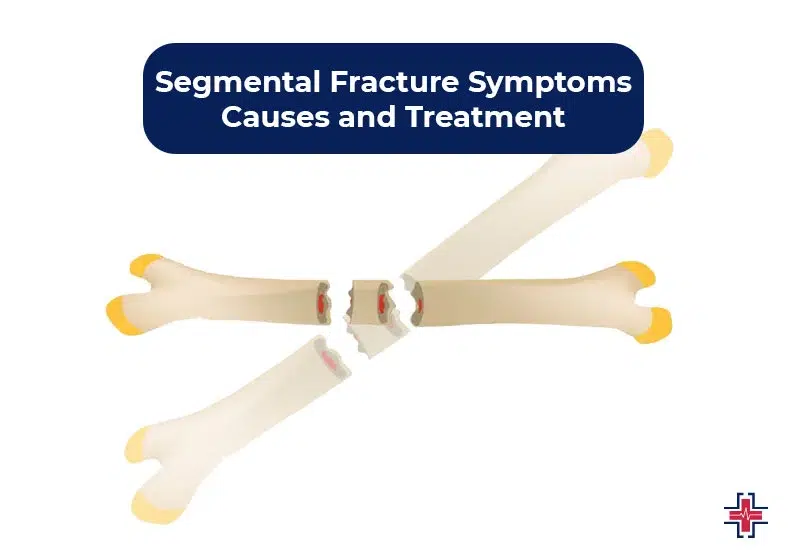A segmental fracture involves at least two fracture lines in a bone and a “segment” of separated bone in between those fracture lines. Sometimes, these medical definitions make sense! They typically happen in the long bones of the arms and legs but can occur elsewhere in the body. In this article, I’ll detail the causes and symptoms of this fracture and how it is treated.
A segmental fracture is typically caused by a high-energy impact, such as could occur in a motor vehicle crash, being ejected from a vehicle or falling from a height. None of these scenarios are desirable and often result in multiple injuries, some of which may be life-threatening and take treatment priority over bone fractures. If available, these fractures will almost always be evaluated by an ER of Mesquite or a Trauma physician.
What Is a Segmental Fracture?
Segmental fractures are a type of broken bone. They happen when one of your bones is broken in at least two places, leaving a segment of your bone separated by the breaks. These fractures can affect any long bone in your body. Some of the most common include:
- Femur (thigh).
- Tibia (shin).
- Fibula (calf).
- Humerus (upper arm).
- Radius and ulna (forearm).
- Clavicle (collarbone).
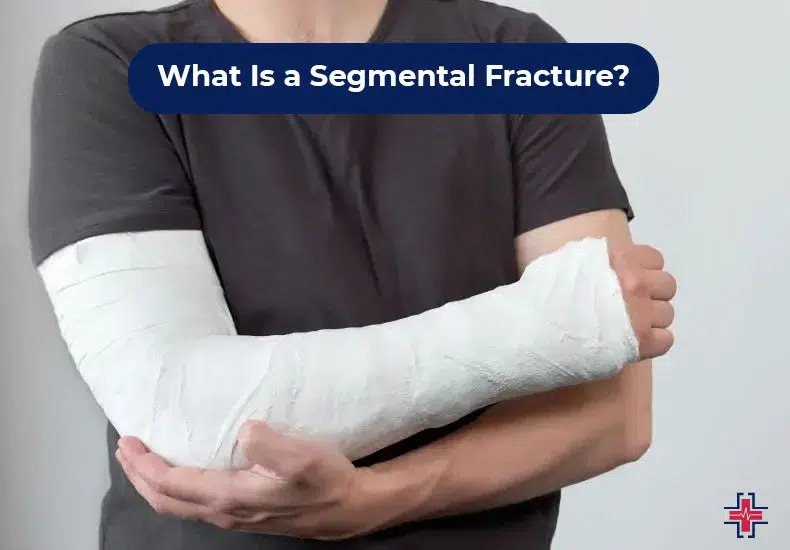
Severe traumas like car accidents almost always cause segmental fractures or falls from high places. They’re extreme, and you’ll likely need surgery to repair your bones. How long it takes to recover fully depends on which of your bones are fractured — and what caused the breaks. Most people need around a year to recover from a segmental fracture.
Who Gets Segmental Fractures?
Segmental fractures — like all bone fractures — can affect anyone. This is especially true because severe traumas cause them. There’s no way to predict when or how someone will be in an accident so that everyone could experience a segmental fracture.
How Does a Segmental Fracture Occur?
The patient will be sent for a series of CT scans, x-rays, and MRI scans to determine the extent of their injuries and to help the trauma team prioritize what injuries need to be handled first. Once any cardiac, vascular, and respiratory issues are seen and the internal organs are taken care of, I would get my turn. The trauma team would have splinted the broken bone(s) to immobilise them and prevent further damage, but any other treatment would be left up to the orthopaedic surgeon.
How Common is Segmental Fracture?
Segmental fractures are relatively uncommon compared to more typical fractures, such as simple or transverse fractures. The incidence of segmental fractures depends on various factors, including the type of trauma or force applied to the bone, the specific anatomical location, and the individual’s overall health.
High-impact injuries, such as those sustained in severe accidents or traumatic events, can increase the likelihood of segmental fractures. Similarly, activities associated with significant stress on bones, like certain sports or occupations, may elevate the risk of this type of fracture. However, most bone fractures are often simple or involve less complex fracture patterns.
It’s important to note that individual factors, including bone health, age, and pre-existing medical conditions, also influence the occurrence of segmental fractures. Conditions that weaken bones, such as osteoporosis or certain tumours, may contribute to an increased risk of segmental fractures in some cases.
While segmental fractures are considered more severe due to their complex nature, they remain relatively rare compared to more uncomplicated fractures. The overall prevalence of segmental fractures is challenging to quantify precisely, as it depends on various factors and varies among different populations and demographic groups.
Comminuted Fractures vs Segmental Fractures
Segmental fractures and comminuted fractures are both serious types of bone fractures. They’re different terms that tell your healthcare provider specific details about how your bones are broken, where they hurt and what they look like inside of your body right now.
Segmental fractures happen when your bone is broken in two different places, and a section of your bone has separated from the rest because of the fracture. Comminuted fractures mean your bone is broken in three or more places. This means some segmental fractures can be comminuted, and some are not.
No matter which names and terms are applied to your fracture, the most essential first step is getting your injury examined by a healthcare provider as soon as possible.
What Are The Symptoms of a Segmental Fracture?
If you have a segmental fracture, you’ll also likely experience severe symptoms of the trauma that caused it. Your symptoms will depend on the other injuries you have. But in general, the symptoms of a segmental fracture can include:
- Intense pain.
- Not being able to move a part of your body that you usually can.
- A part of your body being noticeably different looking or out of its usual place.
- I am seeing your bone through your skin.
- Swelling.
- Bruising.
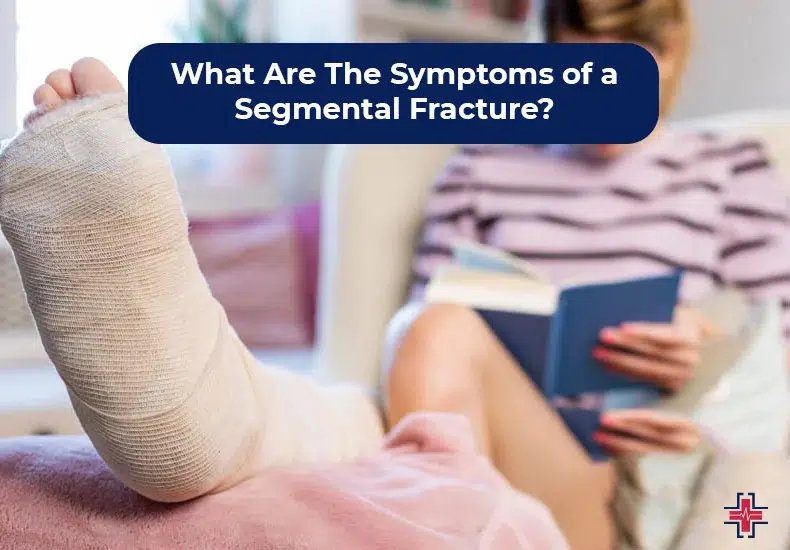
The patient will be sent for a series of CT scans, x-rays, and MR scans to determine the extent of their injuries and to help the trauma team prioritise what injuries need to be handled first. Once any cardiac, vascular, and respiratory issues are seen and the internal organs are taken care of, then I would get my turn. The trauma team would have splinted the broken bone(s) to immobilise them and prevent further damage, but any other treatment would be left up to the orthopaedic surgeon.
What Causes a Segmental Fracture?
Segmental fractures are caused by trauma. Some of the most common causes are car accidents and falls from great heights, like off a ladder or roof.
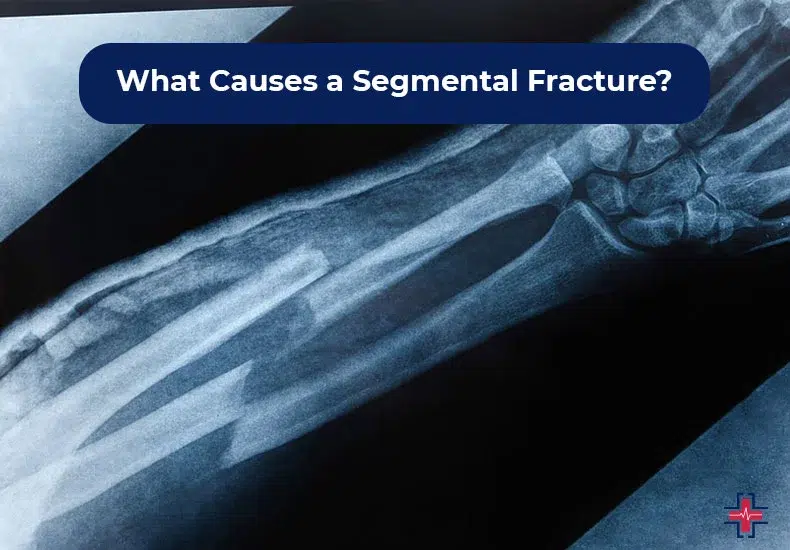
Any impact on your bones can cause a segmental fracture. However, slips falls, and other common causes of broken bones aren’t usually strong enough to damage your bones and cause a segmental fracture.
How Are Segmental Fractures Diagnosed?
Your healthcare provider will diagnose a segmental fracture with a physical exam and imaging tests. In some cases, this may be done in the ER of Mesquite if you’re admitted after a trauma.
If you’re taken to an ER, a team of healthcare providers will work to stabilize you and treat your injuries in the order of severity, especially if some are life-threatening. After you’re stabilized, you’ll need imaging tests to confirm your fracture.
You’ll need at least one of a few imaging tests to take pictures of your fracture:
- X-rays: An X-ray will confirm any segmental or other fractures and show how damaged your bones are.
- Magnetic resonance imaging (MRI): Your healthcare provider might use an MRI to get a complete picture of the damage to your bones and the area around them. This’ll show them tissue around your bones, too. This is especially important to determine how trauma affected your muscles, connective tissue, and organs.
- CT scan: A CT scan will give your healthcare provider or surgeon a more detailed picture of your bones and the surrounding tissue than an X-ray.
What is The Segmental Fracture Treatment?
Almost all segmental fractures are treated with surgery. There are a few techniques used to repair segmental fractures, and which one your surgeon uses will depend on your injuries, which bone is fractured and any other complications after your trauma.
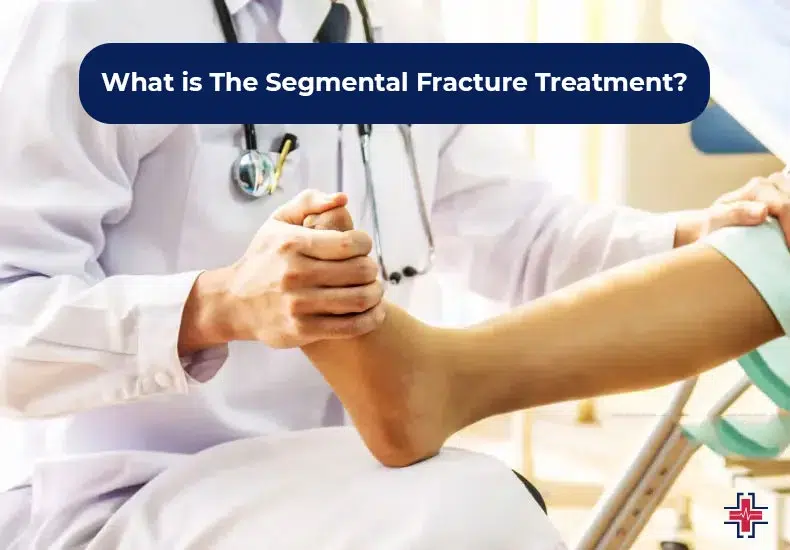
Your surgeon will realign (set) your bones to their correct position and then secure them in place so they can heal and grow back together. They usually perform what’s called an internal fixation, which means your surgeon inserts pieces of metal into your bone to hold it in place while it heals. Internal fixation techniques include:
- Rods: A rod inserted through the centre of your bone that runs from the bottom.
- Plates and screws: Metal plates screwed into your bone to hold them in place.
- Pins and wires: Pins and wires hold pieces of bone in place that are too small for other fasteners. They’ll typically be used at the same time as either rods or plates.
Some people live with these pieces inserted in them forever. You might need follow-up surgeries to remove them.
External Fixation:
You might need an external fixation. This is often a temporary solution that stabilizes your fracture while your other injuries heal. Your surgeon will put screws on either side of the fracture inside your body, then connect them to a brace or bracket around your bone on the outside of your body.
Surgeons sometimes recommend external fixation as a first step before more invasive surgeries to fix your segmental fracture. If you have many other injuries, your body might need time to regain its strength to tolerate internal fixation surgeries. Your surgeon might also use external fixation to stabilise your bone while waiting for the swelling inside your body to go down.
Segmental fracture surgeries are outpatient procedures on their own, which means you might be able to go home the same day. However, it’s likely the trauma that led to your segmental fracture caused other injuries that’ll require you to stay in the hospital to recover.
After your surgery, the part of your body with the fractured bone in it will be immobilised. Depending on where this is, you’ll need some combination of a brace, splint or cast before you can start putting any weight on it again or using it as you did before your injury.
What Medications Are Used to Treat Segmental Fractures?
The treatment of segmental fractures often involves a combination of surgical intervention, physical therapy, and medications to manage pain and support the healing process. While medications alone do not directly heal the fracture, they play a crucial role in pain management and preventing complications. Common drugs used in the treatment of segmental fractures include:
- Pain Relievers (Analgesics): Over-the-counter pain relievers such as acetaminophen (Tylenol) or nonsteroidal anti-inflammatory drugs (NSAIDs) like ibuprofen or naproxen may be prescribed to alleviate pain and reduce inflammation associated with the fracture.
- Prescription Pain Medications: In cases of severe pain, especially after surgery, stronger prescription pain medications like opioids (e.g., oxycodone, hydrocodone) may be prescribed for a limited duration. These medications are typically used cautiously due to the risk of dependence and side effects.
- Bone Health Medications: In situations where osteoporosis or other bone-weakening conditions contribute to the fracture, medications to improve bone density may be prescribed. Examples include bisphosphonates like alendronate or risedronate.
- Antibiotics: If the fracture is associated with an open wound or infection, antibiotics may be prescribed to prevent or treat the disease.
It’s important to note that the primary focus of segmental fracture treatment is often surgical stabilisation and physical therapy to promote proper bone healing and functional recovery. Medications are used as adjuncts to manage pain and address underlying conditions that may affect the healing process. The specific medications and their duration of use will be determined by the treating healthcare professional based on the individual’s health status and the nature of the fracture.
Complications of Segmental Fracture Treatment
Segmental fracture surgery complications include:
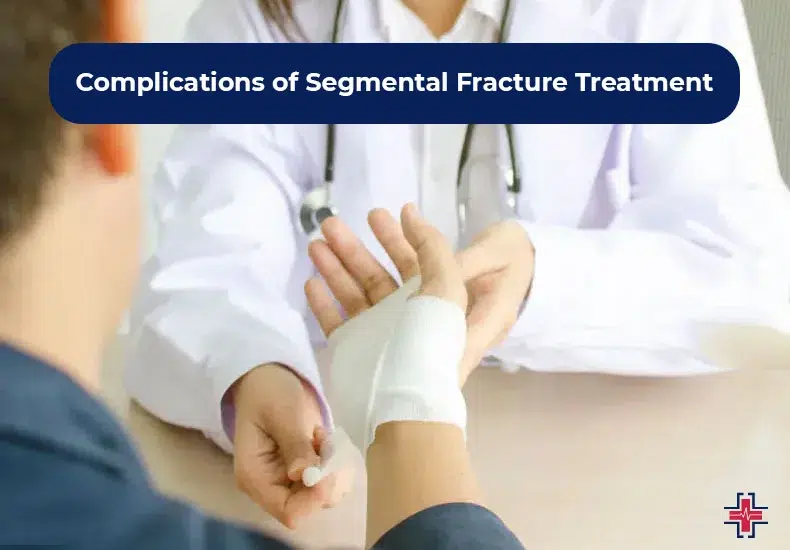
- Acute compartment syndrome (ACS): A build-up of pressure in your muscles may stop blood from getting to tissue, which can cause permanent muscle and nerve damage.
- Malunion: This happens when your broken bones don’t line up correctly while they heal.
- Nonunion: Your bones may not grow back together entirely or at all.
- Bone infection (osteomyelitis): If you have an open fracture (the bone breaks through your skin), you have an increased risk of bacterial infection.
- Other internal damage: Fractures can damage the area around your injury, including your muscles, nerves, blood vessels, tendons and ligaments.
How Can I Prevent a Segmental Fracture?
Because segmental fractures happen suddenly, it’s often impossible to prevent them altogether. You can’t predict when you’ll experience a trauma, so there isn’t anything you can do to avoid a segmental fracture.
What Can I Expect If I Have a Segmental Fracture?
If you have a segmental fracture, you’ll have a longer road to recovery than people who get other types of broken bones. It might take up to a year to heal, especially if you have other injuries from your original trauma.
You’ll need physical therapy to regain strength and range of motion in the injured part of your body. This therapy will be part of your larger recovery plan from other injuries.
How Long Does It Take For a Segmental Fracture of The Humerus Bone To Heal?
Segmental fractures take longer to heal than other kinds of broken bones. They’re also much more likely to involve complications. You’ll likely need to work with healthcare providers at a trauma centre or other specialized facility.
Most segmental fractures take around a year to heal. The exact time it takes your bone(s) to heal will depend on the severity of your fracture and if you develop any complications.
When Should I Go To The Emergency Room?
If you think you have a segmental fracture — or any other broken bone — you need to see a healthcare provider as soon as possible. Go to the emergency room if you experience any of the following:
- Intense pain.
- You can’t move a part of your body that you usually can.
- A part of your body is noticeably different looking or out of its usual place.
- You can see your bone through your skin.
- Swelling.
- New bruising that appears simultaneously with any of these other symptoms.
Go to the emergency room right away if you’ve experienced a trauma.
FAQs
What is a Segmental Tibial fracture?
A segmental tibial fracture involves the tibia bone being broken into two or more separate segments, creating distinct fracture lines.
What is Displaced Segmental Fracture?
A displaced segmental fracture occurs when the broken segments of a bone are not aligned properly, resulting in a misalignment or separation between the fractured parts.
What Characterizes a Segmental Rib Fracture?
A segmental rib fracture refers to a break in a rib bone where there are two or more separate pieces, rather than a single, continuous break.
Segmental Bone Fracture How to Describe it?
A segmental bone fracture is a type of fracture where a bone breaks into two or more distinct segments, each separated by a gap.
Distinguish Between Comminuted and Segmental Fractures
Comminuted fractures involve the bone being shattered into multiple fragments, while segmental fractures have distinct separated segments without the fragmentation seen in comminuted fractures.
How is a Segmental Fracture of The Femur Characterized?
A segmental fracture of the femur involves the thigh bone breaking into two or more separate segments, creating distinct fracture lines along the length of the bone.
Conclusion:
Segmental fractures occur during traumas that can be life-threatening. The scariest part of these injuries is that you can’t usually prepare for them. The good news is that surgeries to repair segmental fractures have very high success rates. Recovering from a significant injury can seem like an impossible job, but take your healing journey one step at a time and celebrate your progress as you go.
If you and your loved ones get a sudden injury and have pain, then you should go to the ER of Mesquite for urgent treatment.
